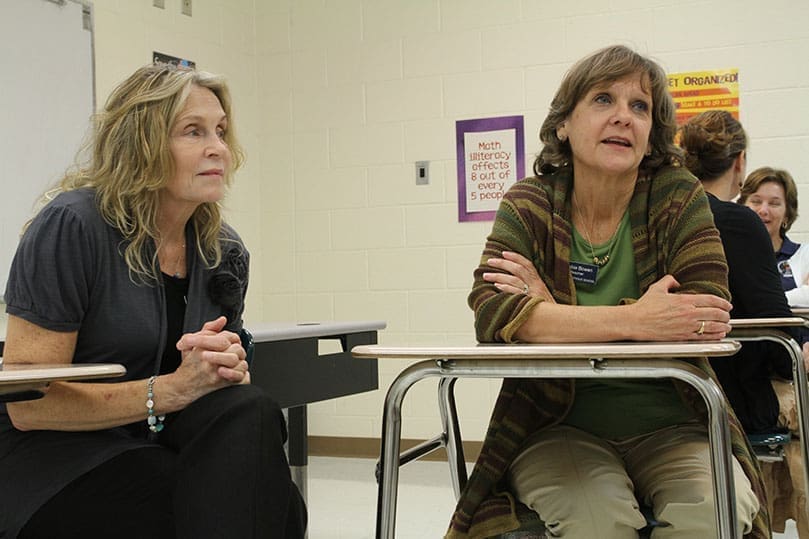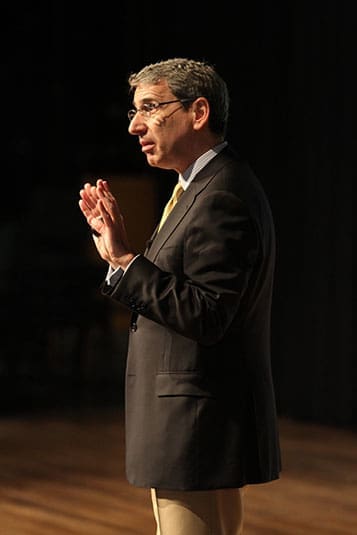 Photo By Michael Alexander
Photo By Michael AlexanderRoswell
Catholic school faculty treated to day of learning
By STEPHEN O'KANE, Staff Writer | Published October 13, 2011
ROSWELL–Students remember only 5 percent of what they hear in a classroom lecture, but 90 percent of what they learn when students teach other students, educators were told at a recent workshop.
The immediate use of knowledge and learning is the most effective teaching method, said Christian Brother Robert R. Bimonte, executive director of the National Catholic Educational Association Department of Elementary Schools.
He gave a presentation on the campuses of Blessed Trinity High School and Queen of Angels Elementary School in Roswell on Friday, Sept. 30. More than 700 Catholic school faculty, administrators and professional staff attended the event, which included breakout sessions on topics from catechesis to teaching methods.
The NCEA Elementary Executive Committee provided the in-service day free for archdiocesan educators and staff. Dr. Diane Starkovich, archdiocesan superintendent of schools, said she was contacted last spring about the possibility of the program being offered in the Archdiocese of Atlanta this fall.

Lynn Denson, foreground, a middle school language arts teacher at St. Mary’s School, Rome, and Marta Lane, a Spanish teacher at Immaculate Heart of Mary School, Atlanta, listen to a speaker during an afternoon breakout session. Photo By Michael Alexander
She said the executive committee for the Department of Elementary Education generally arrives a day early for its fall meeting and on that day, the in-service is provided. The committee looks for a diocese where there are enough teachers and facilities to make the gathering feasible.
“I believe the size of our teaching staffs and the ability to use both Blessed Trinity and Queen of Angels for the in-service was very appealing to NCEA,” said Starkovich. “Archbishop Gregory also serves as the chairman of the board of NCEA, and I believe our national organization has come to know of our excellent Catholic schools through meetings with the archbishop.”
Auxiliary Bishop Luis Zarama celebrated Mass in the morning. In a keynote address, Brother Bimonte spoke about the brain and learning patterns, giving educators a scientific basis on which to build their teaching methods.
He explained the concept of a triune brain, consisting of a “reptilian brain” that deals with the basics of survival, the limbic brain that focuses on emotions, and the cerebral cortex, the largest part of the brain, that plays a role in memory, attention and language.
“We are created in the image and likeness of God,” said Brother Bimonte. “We have a triune God who created us with a triune brain.”
He stressed the need for educators to stimulate the limbic brain, accessing the child’s emotions and strengthening memorization skills and the recollection of information. If you want the brain to be engaged, you have to stimulate the limbic brain, he said.
“Brother Bimonte reminded us that we must engage our students, be creative in our teaching, and realize that our students’ brains process information in a variety of manners,” said Starkovich. “Students do not all learn in the same manner, and it is up to us to create lessons which will reach all learning styles. In addition, we must always remember to infuse our Catholic beliefs and traditions across all subjects.”
During the lunch break, many teachers discussed and compared their methods, some of which have changed since they learned to teach. A hot topic of discussion was the use of iPads and other new technologies. The iPads have advantages and disadvantages, but overall the teachers seemed to approve of the use of the iPad for educational purposes. At first students see the iPad as a toy, it seems, but as more time passes, the lessons are getting more effective.
Whatever the ultimate verdict is on the use of technology in the classroom, teachers said they like teaching in Catholic schools.
Erin McBride, a middle school math teacher at Our Lady of the Assumption School, is an alumna of the Atlanta school and now teaches with some of the same faculty who taught her. She finds the Catholic atmosphere of the school helpful in teaching children.
“You have a lot in common with your kids without even trying,” she said. “I love teaching in the faith. It’s who I am.”

Christian Brother Robert R. Bimonte, NCEA Department of Elementary Schools executive director, delivers the keynote address during the NCEA Elementary Executive Committee in-service provided to the Archdiocese of Atlanta Catholic Schools, Sept. 30. Photo By Michael Alexander
Several of the breakout sessions, which were conducted by NCEA executive members, took place in the afternoon and focused on the Catholicity of the classroom. Overall the topics ranged from the use of media to how teachers can positively change their schools.
“The afternoon sessions were highly engaging,” Starkovich said. “All of the presenters modeled effective teaching in their presentations.”
Brother William Campbell, associate executive director of the NCEA Elementary Department, presented a session on the transforming power of the teacher. He explored the various ways in which teachers can have a positive effect on a student’s life.
“What we do as teachers and educators is transform lives,” he said, adding that sometimes it is hard to see that fact day-to-day.
“You don’t have to do extraordinary things to be a saint. You have to do ordinary things in an extraordinary way,” said Brother Campbell. “Every facet of school life should be filled with respect and reverence. It is how we stand in awe of God and others.”
Starkovich said the response to the in-service day has been overwhelmingly positive.
“The feedback we have received from the principals and teachers has been phenomenal,” she said. “Beginning the day with Mass allowed all of us to frame the day within the mission of our Catholic schools as we attended varying sessions throughout the afternoon.”